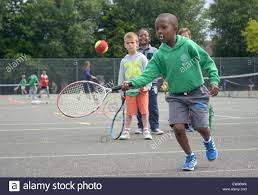TENNIS TIP SINGLES
hit both your first and second serves half to two-thirds as hard as you are capable of serving. This will allow you to get most of your first serves into play. As long as you vary the placement — and spin, if you can — of your serve to keep your opponent off balance, you will be in good shape to win most of your service points. If you do miss your first serve, hit your second serve just as hard.
he perfect toss: Bad serves often are the result of bad tosses. Pretend that the ball is a glass of water that you are balancing on the palm of your hand. Lift your hand upward, releasing the glass upward when your arm is fully extended. Begin your swing when the ball pauses at its apex so that you hit it just as it starts to descend.
Return first serves safely down the middle of the court, five to seven feet above the net (one to two feet above the net and at the server’s feet if the server charges the net after service). The server has the advantage on the first serve. If you try to hit quick winners, you are likely to fail more often than you succeed.
Be more aggressive against a second serve. Move three feet forward, then try to drive your return deep crosscourt.
Hit most ground strokes cross-court in singles tennis. The ball crosses over the net at the net’s lowest point, the middle, when you hit crosscourt, reducing the odds that the ball will hit the net. Because hitting crosscourt lets you aim at the long diagonal dimension of the court, it also reduces the odds that you will hit long — and increases the distance that your opponent must run.
When in trouble, hit up. When your opponent has you on the run, lob your return high and deep. Lobbing forces him to retreat to the backcourt and gives you a chance to regroup.
Coconut water . Blueberries .Sardines. Walnuts
Sweet potatoes. Green tea. Turmeric.
